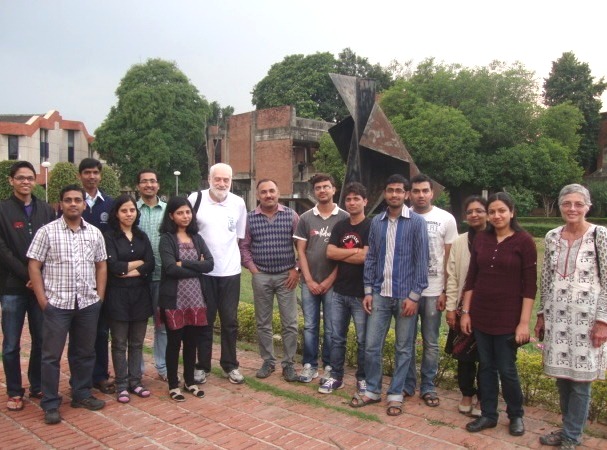
Metal-Organic Nano Sheets May Help Develop Novel Lens Material
- News
- 2.1K
Photochromic materials can change color under stimulation of light. They are of high commercial importance for ophthalmic lens industry as also in sectors like optoelectronic switching devices, data storage, and optical transmission.
Photochromic materials change colors on account of changes in the arrangement of atoms in materials. Atoms in photochromic materials are arranged in a certain manner and change when exposed to sunlight or UV light. We can observe this reversible behavior in sunglasses. However, there are challenges associated with polymers. It is restricted by what features are desired in polymers in terms of rigidity, hardness and scratch resistance. Presently, researchers achieve photoswitching by linking photo chromes covalently to soft low-molecular-weight polymers.

Prof. J N Moorthy and his team
A team of researchers at Indian Institute of Technology (IIT), Kanpur have demonstrated that porous 2-dimensional metal-organic nanosheets (MONs) constructed from photochromic building blocks can also be employed as agents or dopants in polymers to bring out the desired optical properties in photochromic polymers.
Three-dimensional porous metal-organic framework materials (MOFs) have been used for various applications like photo-controlled gas storage, separations, sensing, and catalysis in recent years. However, they are not suitable for use in thin films and polymeric matrices to develop photo-responsive materials, as they pose problems like leaching and poor photoswitching.
The new photochromic 2D metal-organic nanosheets (MONs) are envisaged to be applicable not only in ophthalmic lenses but also in other related applications, where light-induced switching between two or more species with different optical properties must occur smoothly.
Speaking to India Science Wire, leader of the team Prof. J. N. Moorthy said, “Photo-responsive MONs can find applications in ophthalmic industry. As photo-chromes distributed in polymeric 2D nanosheets can be impregnated in rigid polymeric matrices, leaching of photo-chromes can be overcome, besides providing practical simplicity in terms of fabrication. The concept can also be exploited for photo-controlled sieving of organic molecules.”
Commenting on the work, Prof. Rahul Banerjee from Indian Institute of Science Education and Research (IISER), Kolkata, who was not involved in this study, said, “this is an interesting finding in which researchers could show that exfoliation of layered porous metal-organic frameworks (MOFs) using a top-down approach can help produce 2D metal-organic nanosheets (MONs). This type of crystal engineering approach is quite novel and could bring in a novel and new applications in the field of MOFs.”
Prof. Gautam R. Desiraju, Indian Institute of Science, Bangalore, who too was not involved in the study, said, “MOFs as a field is getting saturated and plateauing out. It may require a new vision over the next five to ten years. This subject is not associated with organic chemistry alone. Multi-disciplinary study of MOFs may move in advantageous directions in the future. Chemistry is looking for new paradigms, where the essence of the old is clubbed with a whole new superstructure, combining vertical and horizontal ways of thinking.”
The study has been published in the latest issue of journal CHEM. Besides Prof. Moorthy, the research team included Arindam Mukhopadhyay, Vijay Kumar Maka, and Govardhan Savitha. The study was funded by Science and Engineering Research Board (SERB) of the Department of Science and Technology (DST). (India Science Wire)
By Ratneshwar Thakur
Journal Article
For the latest Science, Tech news and conversations, follow Research Stash on Twitter, Facebook, and subscribe to our YouTube channel


